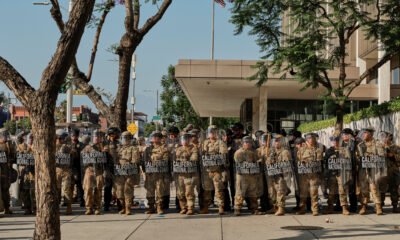U.S. News
You Can’t Arrest Someone for Their Accent Judge Shuts Down Trump’s Immigration Raids in Los Angeles After Shocking Court Findings
A federal judge has ruled that the Trump administration’s immigration arrests in Southern California lacked probable cause and violated constitutional rights—blocking ICE from using race, language, or job as justification for detentions.

In a decisive rebuke to the Trump administration’s immigration tactics, a federal judge on Friday ordered the Department of Homeland Security (DHS) to immediately halt immigration arrests without probable cause in Southern California, ruling that race, language, or occupation cannot be used to justify detentions.
The ruling, issued by U.S. District Judge Maame Ewusi-Mensah Frimpong—an appointee of former President Joe Biden—follows a lawsuit filed by the ACLU of Southern California on behalf of five individuals and several advocacy organizations.
This Court decides—based on all the evidence presented—that they are,” Judge Frimpong wrote, concluding that the administration was conducting roving patrols without legal justification and denying detainees access to legal counsel.
ICE Raids Without Reason: No Bed, No Shower No Lawyer
The court order bars DHS and its affiliated agencies, including Immigration and Customs Enforcement (ICE), the Justice Department, and the FBI, from arresting individuals in the Central District of California based solely on:
- Race or ethnicity
- Spoken language or accent
- Presence in public spaces like bus stops
- Type of employment
Judge Frimpong criticized the government’s arguments, noting that DHS had failed to produce even a single documented case showing reasonable suspicion in its raids.
It’s hard for the court to believe you couldn’t find one case with a report of why someone was targeted,” she said during Thursday’s hearing.
The lawsuit also revealed troubling conditions in a facility known only as “B-18”, where detainees were allegedly denied basic human necessities like beds, showers, and medical care, and were prevented from contacting attorneys.
In response, the judge issued a separate temporary restraining order blocking DHS from denying access to legal counsel at that facility.
“Unconstitutional and Inhumane,” Says ACLU
Mohammad Tajsar, senior staff attorney for the ACLU of Southern California, celebrated the ruling as a win for civil rights:
No matter the color of their skin, what language they speak, or where they work, everyone is guaranteed constitutional rights to protect them from unlawful stops.
The judge’s ruling requires DHS to create written guidance for its officers on what constitutes “reasonable suspicion” and to maintain arrest documentation that will be reviewed by plaintiffs’ counsel.
Political Fallout: Trump vs. California Heats Up
Since returning to the White House, President Donald Trump has renewed his campaign to crack down on immigration, directing ICE to expand deportation operations in Democratic-led cities and deploying thousands of National Guard troops to Los Angeles last month during protests against immigration raids.
In response to the ruling, DHS spokesperson Tricia McLaughlin issued a scathing statement:
A district judge is undermining the will of the American people.
But California Governor Gavin Newsom posted defiantly on.
California stands with the law and the Constitution — and I call on the Trump Administration to do the same.
Los Angeles Mayor Karen Bass echoed the sentiment, calling the court’s action:
An important step toward restoring safety, security, and defending the rights of all Angelenos.
Broader Implications Ahead
Though the ruling is limited to the seven counties within the U.S. Central District of California, it may influence future lawsuits and embolden similar legal challenges nationwide.
This case is a reminder that no administration, regardless of politics, can bypass constitutional protections,” said one immigration law expert.
With tensions rising between federal enforcement and local jurisdictions, this decision adds to the ongoing debate over “sanctuary cities”, civil liberties, and the limits of executive power on immigration.
U.S. News
Michigan church horror revealed who was Thomas Jacob Sanford the man behind deadly attack
Authorities identified Thomas Jacob Sanford, 40, as the suspect in the Grand Blanc church shooting that left four dead and eight injured before ending in a deadly police standoff.

The quiet Sunday morning service at The Church of Jesus Christ of Latter-day Saints in Grand Blanc, a suburb of Flint, Michigan, turned into tragedy when a man rammed his pickup truck into the building and opened fire on worshippers.
Police have now identified the suspect as Thomas Jacob Sanford, a 40-year-old resident of Burton, Michigan. Authorities confirmed that Sanford killed four people and injured eight others in a shocking act of violence that has left the local community in mourning.
ALSO READ : Dutch firm Amdax raises $23M to chase 1% of Bitcoin supply what it means for global markets
The attack
At approximately 10:25 a.m. on September 28, Sanford drove his vehicle into the church packed with hundreds of congregants. According to Grand Blanc Township Police Chief William Renye, the suspect then exited the truck armed with an assault rifle and began firing “several rounds” at terrified attendees.
Officials said Sanford also used gasoline as an accelerant to ignite a fire inside the church, further escalating the chaos. Worshippers scrambled for safety as smoke and gunfire filled the sanctuary.
Victims and condition
Of the eight injured, authorities confirmed one remains in critical condition while seven others are in stable condition. The identities of the victims have not yet been released publicly. Community members gathered for a candlelight vigil outside the church Sunday night, holding hands and praying for those who lost their lives.
How the standoff ended
After unleashing terror inside the church, Sanford exchanged gunfire with responding officers in the parking lot. He was fatally shot during the confrontation, ending the immediate threat but leaving behind haunting questions about his motive.
Michigan State Police described the incident as “one of the deadliest mass shootings in the state in recent years.”

Who was Thomas Jacob Sanford?
Law enforcement officials are still piecing together Sanford’s background. Records confirm he was a longtime resident of Burton, Michigan. Neighbors described him as “quiet but troubled,” though no official motive has been established.
Investigators are now combing through Sanford’s digital history, social media activity, and any potential ties to extremist groups. At this stage, authorities have not confirmed whether the attack was religiously or politically motivated.
Reactions pour in
The tragedy has drawn national attention. Michigan Governor Gretchen Whitmer said she was “heartbroken for the victims and their families” and vowed to support law enforcement in the investigation.
President Joe Biden’s administration has also been briefed, with the White House releasing a statement condemning the violence and offering federal support to Michigan authorities.
Faith leaders across the country expressed solidarity with the congregation. Russell M. Nelson, president of The Church of Jesus Christ of Latter-day Saints, urged members “not to lose hope in the face of such darkness.”
A community in shock
Grand Blanc residents are struggling to process the horror. “This is a place we thought was safe, a house of God,” one church member told local reporters, his voice breaking. “We never imagined something like this could happen here.”
Counselors have been made available for survivors and families of the victims. Local schools in the Flint area also announced they would provide grief support services for students and staff impacted by the shooting.
The bigger picture
The Michigan church attack comes amid a broader national debate on gun violence and security at places of worship. Advocacy groups like Everytown for Gun Safety have reiterated their calls for stronger legislation, while law enforcement agencies stress the need for preparedness against mass casualty events.
For now, the question haunting Grand Blanc is simple but profound: why? Why would Thomas Jacob Sanford unleash such horror on innocent worshippers? Authorities have promised answers, but for the families who lost loved ones, no explanation will ever be enough.
U.S. News
DOJ Lawsuit Against Uber Sparks 5 Shocking Allegations of Disability Discrimination
The Justice Department accuses Uber of violating the ADA while riders with service animals and wheelchairs share distressing stories.

The U.S. Department of Justice (DOJ) has filed a lawsuit against Uber, alleging that the global ride-sharing giant has discriminated against disabled riders, including those with service animals and mobility devices. Filed in the Northern District of California on September 11, 2025, the complaint claims Uber violated Title III of the Americans with Disabilities Act (ADA), which prohibits private transportation companies from engaging in discriminatory practices.
“For too long, blind riders have suffered repeated ride denials by Uber because they are traveling with a service dog,” said Harmeet K. Dhillon, Assistant Attorney General for the DOJ’s Civil Rights Division, in a statement dated September 12. “This lawsuit seeks to end this persistent discrimination and allow riders with disabilities to use Uber.”
Uber’s Official Response
In response to the DOJ allegations, Uber issued a statement to USA Today on September 16, saying it “disagrees with the claims” but emphasized its commitment to accessibility.
“Riders who use guide dogs or other assistive devices deserve a safe, respectful, and welcoming experience on Uber—full stop,” the company said. It added that every Uber driver must acknowledge and comply with its U.S. Service Animal Policy before using the app.
Uber further noted that it has a zero-tolerance policy for service denials, and any confirmed violation can lead to permanent account deactivation of drivers. “When we confirm a violation, we take decisive action,” Uber said, while also pointing riders to its Accessibility Help Center in the app and online.

What the DOJ Alleges
The lawsuit details harrowing accounts from individuals across the United States. Blind passengers with guide dogs, wheelchair users, and people with cerebral palsy or neurological disorders report being left stranded, denied service, or charged unfair fees.
- Cleaning fees for service dogs – Riders said they were charged surcharges for dog hair or “cleaning.”
- Cancellation charges – Many claim they were forced to pay cancellation fees after drivers refused to take them.
- Drivers speeding away – Multiple complaints highlight instances where Uber drivers drove off after spotting service animals.
- Refusal to accommodate wheelchairs – Passengers reported that some drivers outright declined to transport their mobility devices.
The DOJ argues that such practices have caused riders to miss important appointments, face long delays, and even be stranded in severe weather conditions.
ADA at the Center of the Battle
The ADA, signed into law in 1990 by President George H. W. Bush, was designed to guarantee equal opportunities for individuals with disabilities. Title III specifically applies to private businesses that provide public accommodations, including transportation services like Uber.
The DOJ says Uber’s policies and practices undermine the ADA’s intent, and that the court must intervene to ensure compliance.
What the DOJ Wants
The lawsuit seeks:
- A court order mandating Uber comply with the ADA.
- Policy modifications to ensure service animals and wheelchairs are fully accommodated.
- Training programs for Uber staff and drivers on accessibility law.
- Monetary compensation for affected riders.
- Civil penalties to deter future violations.
“We will enforce the ADA’s guarantee that people with disabilities have equal opportunity and full participation in all aspects of American society, including transportation,” the DOJ said in its release.

Why This Matters for Ride-Sharing
If successful, the lawsuit could reshape ride-sharing regulations across the U.S., forcing companies like Uber and its rival Lyft to implement stronger protections for disabled riders.
Legal experts suggest the case may expand how ADA enforcement applies to emerging gig-economy services. Disability rights advocates, meanwhile, see this lawsuit as a turning point that could finally hold big tech-driven companies accountable for accessibility.
Uber’s Future Under Scrutiny
For Uber, this lawsuit arrives at a time when it is already under pressure to improve driver relations, expand Uber Eats, and maintain profitability amid global competition. While the company insists it enforces its policies, critics argue that drivers—often independent contractors—still fail to meet legal obligations.
Whether Uber adjusts quickly or faces years of litigation will likely determine how much trust it retains among riders, particularly those with disabilities.
Final Word
The DOJ vs. Uber lawsuit is more than a legal battle—it’s a test of how far society has come in ensuring equity in the digital transportation age. For millions of disabled Americans, the stakes could not be higher.
Stay with Daily Global Diary for real-time updates on this lawsuit and other stories shaping technology, society, and justice.
Automobile News
Ford recalls 355,000 trucks in the US after dashboard glitch raises safety concerns
NHTSA warns blank instrument panels could prevent drivers from seeing critical speed and warning signs

In a major development affecting hundreds of thousands of vehicle owners, Ford Motor Company has announced a recall of more than 355,000 trucks sold in the United States due to a critical dashboard display failure. The National Highway Traffic Safety Administration (NHTSA) flagged the issue, warning that it could increase the risk of accidents by preventing drivers from accessing essential driving information.

Which models are affected?
According to the regulator, the recall covers several 2025–2026 models, including the Ford F-550 SD, F-450 SD, F-350 SD, F-250 SD, and the upcoming 2025 Ford F-150, one of the company’s most iconic trucks. These vehicles are widely popular in the American market for their durability and performance, which makes this recall particularly significant.
Table of Contents
What’s the problem?
The glitch lies in the instrument panel cluster (IPC) — the section of the dashboard that shows vital data like the speedometer, tachometer, fuel gauge, engine temperature gauge, and odometer. Due to a computer error occurring when the system tries to enter sleep mode, the IPC may appear completely blank when the vehicle is started.
In its statement to FOX Business, Ford explained:
“This condition can prevent safety-related telltales and gauges from being readable, increasing the risk of a crash as critical safety information may not be displayed.”
Safety concerns and Ford’s response
While Ford has acknowledged 95 warranty claims and one official vehicle owner complaint related to the issue, the company insists that no accidents or injuries have been reported so far. Still, the safety implications are undeniable. A blank dashboard means drivers could lose visibility of crucial indicators such as speed, fuel levels, and engine warnings.

To address the problem, Ford is rolling out a software update. Customers can either visit their nearest Ford or Lincoln dealer to have the update installed, or they may receive an over-the-air (OTA) software fix directly on their vehicle — a solution that many see as more convenient.
What should owners do?
Ford will begin contacting affected owners by mail, instructing them to bring their vehicles in for the free software update. Alternatively, many trucks will receive the OTA update automatically, disabling the faulty memory protection feature in the IPC system.
Customers who want more details can call Ford’s toll-free helpline at 1-866-436-7332 or contact their local Ford or Lincoln dealer with the reference code FSA 25S88.

The bigger picture
Vehicle recalls are not new in the U.S., but this one highlights the increasing reliance on automotive software and how even minor coding errors can translate into major safety risks. Analysts note that while Ford’s quick OTA solution is reassuring, recalls of this scale can affect customer confidence in the brand, especially when it involves safety-critical systems.
For now, Ford truck owners are being urged to take immediate action once notified to ensure their vehicles remain safe on the road.
For more Update http://www.dailyglobaldiary.com
-

 Entertainment1 week ago
Entertainment1 week agoAlyssa Milano removes breast implants says she finally feels free and authentic
-

 Sports1 week ago
Sports1 week agoSeattle Mariners end 24 year drought as Cal Raleigh belts No 60 to clinch AL West crown
-

 Technology News1 week ago
Technology News1 week agoChina opens Shanghai digital yuan hub to rival US dollar but here’s the bigger plan
-

 Entertainment6 days ago
Entertainment6 days agoDolly Parton delays Las Vegas concerts by nine months citing health challenges but promises unforgettable return
-

 Sports1 week ago
Sports1 week agoLionel Messi scores twice with assist as Inter Miami crushes New York City FC fans stunned by his masterclass
-

 Politics1 week ago
Politics1 week agoUS Senate to grill Coinbase executive as crypto tax fight heats up next week
-

 Entertainment1 week ago
Entertainment1 week agoScarlett Johansson breaks silence on Colin Jost’s SNL future fans surprised by her answer
-

 Entertainment6 days ago
Entertainment6 days agoZoey Deutch engaged to comedian Jimmy Tatro after 4 years of dating with romantic beach proposal




























